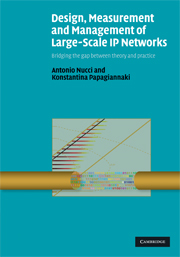 Design, Measurement and Management of Large-Scale IP Networks
Design, Measurement and Management of Large-Scale IP Networks Book contents
- Frontmatter
- Contents
- Acknowledgments
- 1 Introduction
- 2 Background and context
- I Network monitoring and management
- II Network design and traffic engineering
- III From bits to services
- Appendix A How to link original and measured flow characteristics when packet sampling is used: bytes, packets and flows
- Appendix B Application-specific payload bit strings
- Appendix C BLINC implementation details
- Appendix D Validation of direction-conforming rule
- References
- Index
Appendix D - Validation of direction-conforming rule
Published online by Cambridge University Press: 05 September 2012
- Frontmatter
- Contents
- Acknowledgments
- 1 Introduction
- 2 Background and context
- I Network monitoring and management
- II Network design and traffic engineering
- III From bits to services
- Appendix A How to link original and measured flow characteristics when packet sampling is used: bytes, packets and flows
- Appendix B Application-specific payload bit strings
- Appendix C BLINC implementation details
- Appendix D Validation of direction-conforming rule
- References
- Index
Summary
Due to the challenges of obtaining an AS topology annotated with AS relationships, it is infeasible to use the valley-free rule to identify redistribution path spoofing in the work. Alternatively, we apply the direction-conforming rule to the AS topology annotated with directed AS-links to carry out the detection. The following theorems show that the direction-conforming rule actually shows roughly equivalent efficiency.
Theorem D.1
For an observer AS, a valley-free path in the AS topology annotated with AS relationships must be “direction-conforming” in the corresponding AS topology annotated with inferred directed AS-links.
Theorem D.2
(1) For a Tier-1 AS, the direction-conforming paths in the AS topology annotated with inferred directed AS-links must be valley-free in the real AS topology annotated with AS relationships.
(2) For a non-Tier-1 AS, except the redistribution path-spoofing paths launched by the provider ASs, the direction-conforming paths must be valley-free.
In order to prove these theorems, we first investigate the mapping between the real AS topology annotated with AS relationships and the inferred AS topology annotated with directed AS-links.
Note that, similar to the analysis in the text, we assume that the inferred topology is “ideally” complete, namely it contains all legitimate directed AS-links that the observer AS should see. In order to infer a complete AS topology comprising of directed AS-links based on the route announcements from the observer AS, we assume an ideal inference scenario, in which the AS connections and relationships do not change over the inference period and every AS tries all possible valid routes.
- Type
- Chapter
- Information
- Design, Measurement and Management of Large-Scale IP NetworksBridging the Gap Between Theory and Practice, pp. 379 - 381Publisher: Cambridge University PressPrint publication year: 2008
